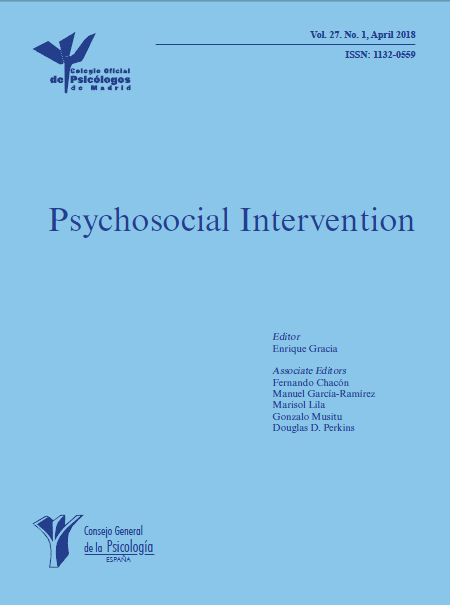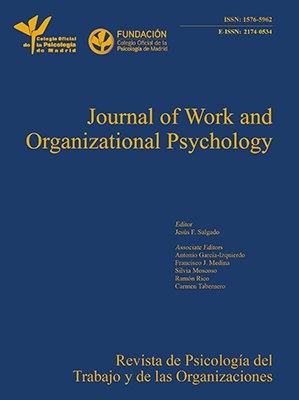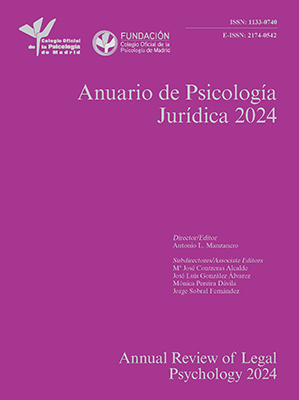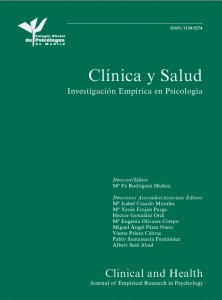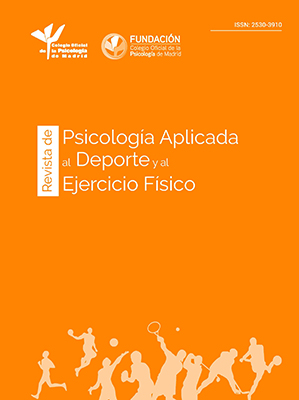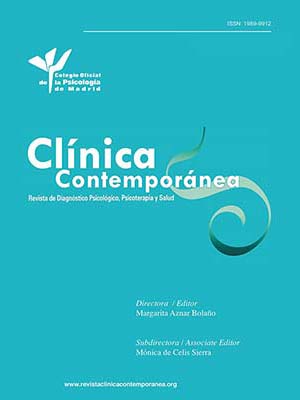
Examining the Impact of Self-concept on Adolescents’ Self-regulated Learning: A Predictive Modeling Approach
[El análisis de la relación entre el autoconcepto y el aprendizaje autorregulado en los adolescentes: un enfoque de modelos predictivos]
Patricia Ayllón-Salas, José L. Arco-Tirado, and Francisco D. Fernández-Martín
University of Granada, Spain
https://doi.org/10.5093/psed2025a5
Received 6 February 2024, Accepted 19 September 2024
Abstract
The aim of the present study was to explore the relationship between self-concept and self-regulated learning in secondary education students. For this purpose, self-concept and self-regulated learning were measured in 923 participants. The results of the study suggest that academic, social, emotional, physical, and family self-concept could predict the use of self-regulated learning strategies (i.e., affective motivation and value motivation). Therefore, the constructed models explained 15% and 18% of the variance in affective motivation and value motivation, respectively. All self-concept dimensions emerged as positive predictors of affective motivation, while academic, social, family, and physical self-concepts were identified as significant predictors of value motivation. In summary, the results of this study suggest that self-concept enhances the use of self-regulated learning strategies in the academic field.
Resumen
El objetivo del presente estudio ha sido explorar la relación entre el autoconcepto y el aprendizaje autorregulado en alumnos de educación secundaria. Para ello se midieron el autoconcepto y el aprendizaje autorregulado en 923 participantes. Los resultados del estudio indican que las dimensiones del autoconcepto (i.e., académico, social, emocional, físico y familiar) podrían predecir el uso de estrategias de aprendizaje autorregulado. Por tanto, los modelos planteados explicaron el 15% y el 18% de la varianza de la motivación afectiva y la motivación valor, respectivamente. Todas las dimensiones del autoconcepto han sido predictoras positivas de la motivación afectiva, mientras que los autoconceptos académico, social, familiar y físico han sido predictores significativos de la motivación de valor. En definitiva, los resultados de este estudio muestran que el autoconcepto potencia el uso de estrategias de aprendizaje autorregulado en el ámbito académico.
Palabras clave
Autoconcepto, Aprendizaje autorregulado, Estrategias de aprendizaje, EducaciĂłn secundaria, AdolescentesKeywords
Self-concept, Self-regulated learning, Learning strategies, Secondary education, AdolescentsCite this article as: Ayllón-Salas, P., Arco-Tirado, J. L., & Fernández-Martín, F. D. (2025). Examining the Impact of Self-concept on Adolescents’ Self-regulated Learning: A Predictive Modeling Approach. PsicologĂa Educativa, 31(1), 37 - 44. https://doi.org/10.5093/psed2025a5
Correspondence: patriay@ugr.es (P. Ayllón-Salas).Academic performance during schooling significantly shapes career, personal, and lifelong success for students (Mammadov, 2021). Consequently, self-regulated learning (SRL) has garnered considerable attention from educational researchers due to its robust association with academic performance (Zimmerman & Moylan, 2009). Students who achieve higher academic success and consequently experience lower rates of school failure tend to employ SRL more extensively (Rodríguez et al., 2017; Stoeger et al., 2015). Hence, the integration of cognitive and motivational variables within SRL renders these skills fundamental for successful school achievement (Valiente-Barroso et al., 2020). Moreover, self-concept has been linked to higher academic performance (Huang, 2011; Wu et al., 2021), which can be potentially attributed to its motivational properties. Students with elevated self-concept demonstrate increased motivation and confidence in their abilities, thus enhancing their performances (Ommundsen et al., 2005). However, the nature of the relationship between self-concept and academic performance remains unclear because it is uncertain whether self-concept predicts academic performance or vice versa and whether certain variables mediate this relationship (Wu et al., 2021). Given the significance of SRL in bolstering academic performance, comprehending variables that may predict its use becomes imperative. Within this context, this study aims to advance current knowledge regarding the association between self-concept and SRL use to enhance academic performance, an area that remains relatively unexplored. Self-regulated Learning (SRL) SRL is a fundamental competence that serves as a cornerstone of lifelong learning (Theobald, 2021) and it is also an essential skill for the 21st century (Kesuma et al., 2020). The significance of education lies in its potential to bolster academic performance across all educational tiers (Theobald, 2021). SRL is a dynamic process wherein learners actively engage in and sustain cognitions, emotions, and behaviors that are systematically directed toward achieving personal goals (Theobald, 2021). SRL requires personal initiative, resource exploration, persistence, and motivation on the learner’s part to construct their learning environment (Pintrich, 2004; Zimmerman, 2000) to generate their own thoughts, feelings, and actions (Zimmerman & Moylan, 2009). Students who engage in SRL exhibit metacognitive abilities, motivation, and active engagement in their learning activities. Consequently, SRL encompasses the development of strategies to achieve learning goals, which are influenced by perceived self-efficacy and commitment to educational objectives (Kesuma et al., 2020). SRL is characterized by a cyclical process consisting of three fundamental phases (Hattie & Timperley, 2007; Zimmerman & Moylan, 2009): (a) anticipation, which involves task analysis and planning, (b) performance, which entails monitoring effort, time, and space, seeking help, or recording progress, and (c) reflection, which involves self-evaluation of achievements in relation to the goals set at the outset and the performance attained. Therefore, the three critical components of SRL are metacognitive strategies, effort management and control, and the use of strategies for learning, remembering, and understanding materials (Pintrich, 2000). Several authors have contributed to the definition and development of SRL models: (a) Boekaerts’ (2000) adaptive learning model highlights internal processes and continuous self-evaluation aligned with goals, empowering students to make adjustments for enhanced performance and progress toward their objectives; (b) Winne and Hadwin’s (1998) model consists of four stages, i.e., task definition, planning for task completion, utilization of cognitive and metacognitive strategies for execution and learning regulation, and process review; (c) Borkowski and Muthukrishna’s (1992) metacognition-oriented model explains how acquiring metacognition fosters higher-level learning strategies, facilitating self-regulation, mastering and consistently applying these strategies enable learners to employ and generalize them across diverse domains; (d) Zimmerman’s (2000) cyclical model encompasses three phases (i.e., reflection or forecasting, performance monitoring, ands elf-reflection), and underscores the importance of feedback throughout the process to adjust and improve the learning; and (e) Pintrich’s (2000) model, which is the most widely employed due to the significance of motivation in the learning process. According to Pintrich’s (2000) model, student motivation alone cannot predict academic success: it must be considered alongside learning strategies. Pintrich integrated three motivational components into his model: (a) expectancy component, that relates to students’ beliefs about their abilities and responsibility for their tasks and encompasses responses to the question “Am I capable of doing this task?”; (b) value component, encompassing students’ task goals, interests, and beliefs about the task’s importance, addressing the question “Why am I doing this task?”; (c) affective component, relating to the emotions experienced by students, and capturing responses to the question “How do I feel about the task?”; students’ anxiety about task performance is particularly significant in this component. Self-concept Self-concept includes individual perceptions and feelings about oneself, evolving over time through interactions with others and their own interpretations of their actions (Shavelson et al., 1976). Self-concept comprises both a descriptive dimension, enabling individuals to describe themselves (e.g., “I am happy”), and an evaluative dimension, facilitating self-assessment (e.g., “I am doing well at work”) (Marsh & Shavelson, 1985). In addition, it is composed of three components or aspects (Fernández, 2006): (a) the cognitive component, which refers to self-image, (b) the affective component, which refers to self-esteem or an individual’s evaluation of themselves, and (c) the behavioral component, which refers to an individual’s motivation. Consequently, self-concept serves as a pivotal mediating construct that influences various psychological and behavioral outcomes, including academic performance, study preferences, and subject interest (Möller et al., 2020). The dimensionality of self-concept has sparked considerable research interest and extensive debate (F. Chen et al., 2020; Marsh & Shavelson, 1985). Self-concept is a multifaceted construct that organizes individuals’ self-knowledge into distinct categories (Marsh & Shavelson, 1985). These categories maintain interconnections and are hierarchically structured (Marsh & Shavelson, 1985). While the overall self-concept remains relatively stable, lower levels of the hierarchy tend to be more situation-specific and consequently less stable (Marsh & Shavelson, 1985). Consequently, the theoretical framework of self-concept is structured around a global dimension that integrates five specific dimensions (i.e., academic self-concept, social self-concept, emotional self-concept, family self-concept, and physical self-concept) (F. García & Musitu, 2014; Shavelson et al., 1976). While the global approach can predict significant variations in psychosocial adjustment and competence (Harris & Orth, 2020; Orth & Robins, 2022), the multidimensional approach offers more specific predictions (F. Chen et al., 2020; F. García et al., 2018; Marsh & O’Mara, 2008). Relationship between Self-regulated Learning and Self-concept Zimmerman (2001) noted that self-concept is closely linked to SRL (Salmerón-Pérez & Gutiérrez-Braojos, 2012). Both constructs include an affective component because while self-concept involves emotional evaluation with respect to others (Choi, 2005), SRL includes evaluation with respect to tasks (Pintrich, 2000). Additionally, self-concept has been associated with locus of control. Students with a positive self-concept are more likely to believe that they have control over their daily circumstances, thereby adopting an internal locus of control (Sagone & Caroli, 2014). In this context, SRL aims to reduce the gap between the real self and the ideal self. It explains how the self-concept is continuously reconstructed to achieve potential futures and desired identities (Salmerón-Pérez & Gutiérrez-Braojos, 2012). Personal motivations and beliefs about personal learning significantly influence students’ SRL (Pintrich, 2000). According to Pintrich’s (2000) model, the motivational components of SRL affect both the regulation of learning and the success of students’ learning goals. It is crucial to recognize that academic performance is not only affected by the use of cognitive and metacognitive strategies but also how students approach the learning process. In this context, self-concept can significantly influence students’ approach to exams and assignments (Ommundsen et al., 2005). Consequently, the academic dimension of self-concept has been extensively studied (e.g., B. H. Chen et al., 2015; Du, 2012; Lohbeck & Moschner, 2022; McInerney et al., 2012; Ommundsen et al., 2005; C. M. Rodríguez, 2009), demonstrating that low self-concept can help explain students’ difficulties in self-regulation (Oyserman & Destin, 2010; Salmerón-Pérez & Gutiérrez-Braojos, 2012). Academic self-concept refers to an individual’s perception of their proficiency in the student role (F. García & Musitu, 2014; Paechter et al., 2022). Students with high self-concept exhibit greater confidence in their abilities, which diminishes the impact of any negative feelings they may experience (Ommundsen et al., 2005), positively influences self-efficacy and motivation (Wang & Yu, 2023), and mitigates the risk of school dropout (Brumariu et al., 2022). Conversely, when these students achieve academic goals, they attribute their success to their abilities and effort, feeling in control of their learning (Ommundsen et al., 2005). Consequently, both self-concept and self-regulated learning are directly linked to students’ learning processes and, ultimately, their academic performance (Huang, 2011; Marsh & Craven, 2006). For instance, McInerney et al. (2012) found that students’ self-concept in English was a positive predictor of self-reported deep-level strategies (i.e., elaboration and organization) as well as surface learning strategies (i.e., rehearsal). Similarly, Lohbeck and Moschner (2021) demonstrated that academic self-concept was significantly positively correlated with organization and elaboration strategies. Beyond academic dimension, other self-concept dimensions also seem to be related to SRL. Social self-concept, for instance, is defined as an individual’s assessment of their interactions in social settings (F. García & Musitu, 2014). This dimension of self-concept includes an affective component (Dueñas et al., 2021) that refers to one’s perceived ability to exercise social control (Preckel et al., 2013). Consequently, individuals who feel more socially adept are more likely to effectively employ the skills needed to seek help in educational settings (Dueñas et al., 2021). Moreover, students who have experienced failure, whether academic or social, may suffer from diminished resources, such as self-confidence, in both academic pursuits and social interactions (Klapp, 2017). On the other hand, emotional self-concept involves an individual’s perception of their emotional state and responses to specific situations (F. García & Musitu, 2014). Therefore, this dimension of self-concept is intricately interconnected with other dimensions, as low emotional self-concept may lead to inadequate emotional regulation, which may have a negative impact on various facets of an individual’s life (Cornellà-Font et al., 2020). Family self-concept includes an individual’s perception of their involvement, participation, and integration in the family environment (F. García & Musitu, 2014). While Shavelson’s (1976) initial model did not incorporate family self-concept, this dimension holds significant importance within the realm of self-concept due to the profound impact that family dynamics have on children’s psychosocial adjustment (Alcaide et al., 2023; Climent-Galarza et al., 2022; Echeverría-Fernández & Obaco-Soto, 2021). Consequently, students who feel more valued within their family context are more likely to persist, strive, self-regulate, and achieve academically (Reyes et al., 2023; Salmerón-Pérez & Gutiérrez-Braojos, 2012). Finally, physical self-concept encompasses an individual’s perception of their physical appearance and overall physical condition (F. García & Musitu, 2014). Young people with stronger beliefs about their physical characteristics are more likely to engage in physical activity than those with lower levels of physical self-concept (Babic et al., 2014). Similarly, a close relationship between physical activity and academic success is mediated by variables such as SRL (Visier-Alfonso et al., 2021). Therefore, the relationship between physical self-concept and SRL can be mediated by physical activity. Young people who are more confident in their physical abilities tend to engage in more exercise, which, in turn, leads to improvements in cognitive skills (Visier-Alfonso et al., 2021). Aim of the Study Although the different dimensions of self-concept appear to be closely related to the use of SRL components, no research has explicitly linked these two constructs. Consequently, the general objective of this study was to explore the relationship between self-concept and SRL. To this end, the following specific objectives were established: (a) determine which dimensions of self-concept are related to the use of SRL components and (b) assess the extent to which self-concept dimensions predict the use of SRL components. Participants The sample consisted of 923 secondary school students from Granada (Spain), consisting of 551 males (59.70%) and 372 females (40.30%). In addition, the average age was 15.67 years (SD = 1.50, age range = 12-18 years), and the distribution by grade level was 250 students in the first year, 216 in the second year, 218 in the third year, and 239 in the fourth year. The sample was selected using a non-probability and convenience sampling method (Kalton, 2020). Materials Spanish version of the Learning Strategies and Motivation Questionnaire (MSLQ; Albert, 2017) The Likert scale employed in this study comprises eight items with four response alternatives (1 = never or rarely, 2 = occasionally, 3 = often, and 4 = almost always or always). It is organized into 5 components and 15 scales focusing on SRL: (a) affective motivation component, i.e., thoughts and emotions involved in the evaluation task (e.g., “I know how to stay calm under pressure”); (b) value motivation component, i.e., participation in learning tasks for intrinsic and extrinsic reasons, as well as the importance, interest and usefulness given to the learning tasks (e.g., “Thanks to my intellectual capacity, I can successfully perform any task or job”); (c) expectancy motivation component, i.e., beliefs about learning outcomes and their control (e.g., “I am confident in my ability to successfully perform any task or job”); (d) resource regulation strategies component, i.e., strategies related to the control and regulation of one’s own behavior (e.g., “Before I start my homework or work, I make sure I have all the materials I might need at hand”); and (e) cognitive and metacognitive strategies component, i.e., strategies related to the basic processes to acquire and process information in learning, and strategies related to the control and regulation of one’s own behavior (e.g., “I concentrate easily on the tasks and work I need to complete”). This adaptation of the MSLQ was validated by Albert (2017) for the specific purpose of measuring learning. The selection of this scale for educational study was based on its established reliability, validity, and appropriateness for administration to high school students. The scale factors collectively accounted for a total variance of 47.99%. For this study, specific components of the scale were utilized: affective motivation, value motivation, expectancy motivation, resource regulation strategies, and cognitive and metacognitive strategies. The internal consistency indexes, measured using Cronbach’s alpha (α) and McDonald’s omega (ω) coefficients for this research, were as follows: (a) affective motivation component, α = .69 and ω = .68; (b) value motivation component, α = .74 and ω = .74; (c) expectancy motivation component, α = .71 and ω = .70; (d) resource regulation strategies component, α = .69 and ω = .69; and (e) cognitive and metacognitive strategies component, α = .71 and ω = .71. Five-factor Self-concept Questionnaire (AF-5) (F. García & Musitu, 2014) This Likert scale is made up of 30 items with four response alternatives (1 = never or rarely, 2 = occasionally, 3 = often, and 4 = almost always or always) that group five dimensions: (a) academic self-concept, i.e., individual’s perception of the quality of their performance in the role of a student (e.g., “I am a hard worker”); (b) social self-concept, i.e., individual’s perception of their performance in social relationships, (e.g., “I make friends easily”); (c) emotional self-concept, i.e., individual’s perception of their emotional state and their responses to specific situations (e.g., “Many things make me nervous”); (d) family self-concept, i.e., individual’s perception of their involvement, participation, and integration within the family environment (e.g., “I feel loved by my family/guardians”); and (e) physical self-concept, i.e., individual’s perception of their physical appearance and overall physical condition (e.g., “I am good at sports”). The theoretical structure has been empirically confirmed through confirmatory factor analyses in Spanish in Spain (Bustos et al., 2015; Esnaola et al., 2011; Murgui et al., 2012), Chile (J. F. García et al., 2011), Portuguese from Portugal (J. F. García et al., 2006), Brazil (F. García et al., 2018), English (F. García et al., 2013), and Chinese (F. Chen et al., 2020). The internal consistency indices (α) median in the five AF-5 dimensions reported by previous studies has been between .71 and .87 (F. García et al., 2018). Indeed, in this study, the questionnaire yielded adequate levels of internal consistency: (a) academic self-concept: α = .88, ω = .87; (b) social self-concept: α = .72, ω = .72; (c) emotional self-concept: α = .74, ω = .74; (d) family self-concept: α = .84, ω = .83; and (e) physical self-concept: α = .73, ω = .73. Design and Procedure The design of this educational study was a predictive cross-sectional (Ato et al., 2013). This work was approved by the Ethics Committee of the University of Granada (1736/CEIH/2020). The procedure followed for administering the AF-5 (F. García & Musitu, 2014) and the Spanish version of the MSLQ (Albert, 2017) was group-based in each of the selected group classes at the participating schools. The administration of the instrument was carried out by the staff of the research team, with the help of the teacher-tutors of each group class. For this purpose, the students were provided with instructions for completing both instruments, as well as the objectives of the research and the importance of sincerity in each of their answers, of course, always guaranteeing their confidentiality and anonymity. Data Analysis The minimum sample size required for the regression analyses was previously calculated (n = 103) considering the number of predictors (7), probability level (.05), anticipated effect size (0.15), and desired statistical power level (.80) (Soper, 2024). First, pre-analysis was performed to identify anomalies, atypical, missing, and influential cases. Second, bivariate correlational analysis was performed using Pearson’s correlation coefficient between self-concept dimensions and SRL components. Subsequently, the variance inflation factor (VIF) and tolerance statistics were calculated to diagnose multicollinearity. Finally, multiple linear regressions were performed using sex and age as moderators. The self-concept dimensions were used as predictors of SRL components that were statistically significant in the correlation analyses (i.e., affective motivation and value motivation). The chi-square test was used to identify the effects of age and sex on SRL. Statistical analyses were performed using JAMOVI 2.3 (The Jamovi Project, 2022). Initially, a pre-analysis was conducted by computing the means and standard deviations of each variable (Table 1). Furthermore, Table 1 presents the results of the bivariate correlation analysis between self-concept dimensions and SRL components. The findings indicate positive correlations between affective motivation and academic self-concept (r = .29, p < .001), social self-concept (r = .21, p < .001), emotional self-concept (r = .17, p < .001), family self-concept (r = .24, p < .001), and physical self-concept (r = .22, p < .001). Likewise, positive correlations were observed between value motivation and academic self-concept (r = .34, p < .001), social self-concept (r = .19, p < .001), family self-concept (r = .31, p < .001), and physical self-concept (r = .17, p < .001). However, no correlations were found between self-concept dimensions and expectancy motivation, resource regulation strategies, and cognitive and metacognitive strategies. Table 1 Mean, Standard Deviation, and Bivariate Correlations Between Self-concept and Self-regulated Learning   Note. M = mean, SD = standard deviation; ASC = academic self-concept; SSC = social self-concept; ESC = emotional self-concept; FSC = family self-concept; PSC = physical self-concept; AM = affective motivation; VM = value motivation; EM = expectancy motivation; RRS = resource regulation strategies; CMS = cognitive and metacognitive strategies. *p < .05, **p < .01, ***p < .001. The results in Table 1 show no multicollinearity between independent variables because the Pearson correlation indicators for all independent variables are less than .70, and the results in Table 2 show that multicollinearity does not exist among all independent variables because tolerance values are more than .10 and VIF values are less than 10. Subsequently, multiple linear regressions were conducted using SRL components that exhibited correlations with various self-concept dimensions. Therefore, two linear regressions were performed: the first aimed to predict affective motivation using academic, social, family, and physical dimensions of self-concept as predictors, while the second aimed to predict value motivation using academic, social, family, and physical dimensions of self-concept as predictors. Table 2 Regression Analysis of Self-concept as a Predictor of Self-regulated Learning  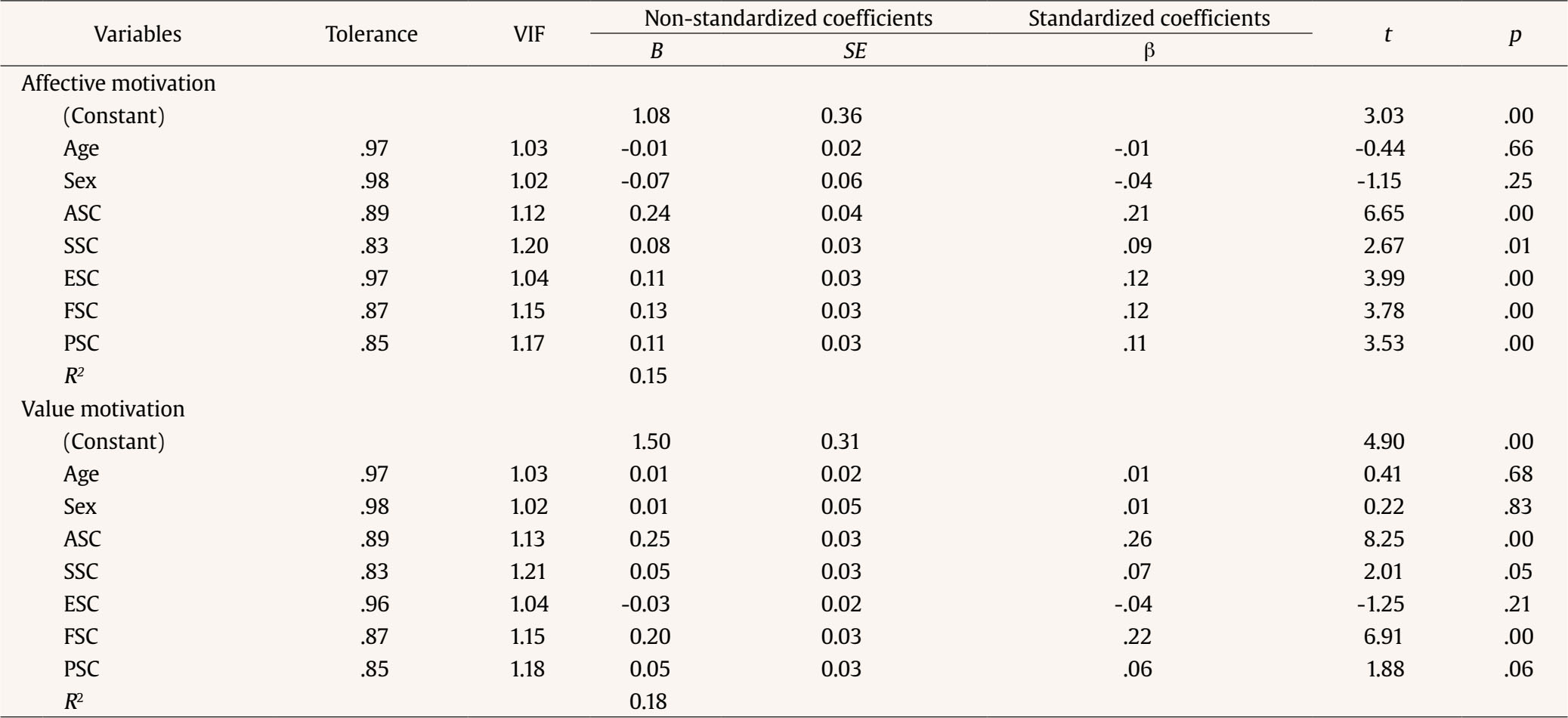 Note. VIF = variance inflation factor; B = non-standardized coefficient; SE = standard error; β = beta coefficient; t = t-test; p = p-value; ASC = academic self-concept; SSC = social self-concept; ESC = emotional self-concept; FSC = family self-concept; PSC = physical self-concept. Both models obtained significant results, explaining 15% and 18% of the variance in affective motivation and value motivation, respectively (Table 2). Academic self-concept (β = .21, p < .001), social self-concept (β = .09, p < .01), emotional self-concept (β = .12, p < .001), family self-concept (β = .12, p < .001), and physical self-concept (β = .11, p < .001) emerged as positive predictors of affective motivation (Table 2). Moreover, academic self-concept (β = .26, p < .001), social self-concept (β = .07, p < .05), and family self-concept (β = .22, p < .001) were identified as significant predictors of value motivation (Table 2). Finally, the results of the chi-square test for age and sex were not significant, indicating that these variables had no effect on affective motivation and value motivation (Table 3). This study explored the relationship between self-concept and SRL. To this end, two specific objectives were established: (a) determine which dimensions of self-concept are related to the use of SRL components and (b) assess the extent to which self-concept dimensions predict the use of SRL components. Regarding objective 1, the study results revealed a connection between self-concept and SRL in adolescents. More specifically, self-concept dimensions were associated with both value motivation and affective motivation. These findings align with prior research indicating that the use of motivational regulation strategies is inherently linked to the subjective valuation of tasks (Lohbeck & Moschner, 2021). Ommundsen et al. (2005) investigated how academic self-concept and SRL components affect each other and discovered that while motivation strategies were positively correlated with academic self-concept, these strategies only showed weak associations. However, the cognitive and metacognitive strategies, resource regulation strategies, and expectancy motivation components were not significantly related to the dimensions of self-concept. This may be because the relationship between these SRL components and the various dimensions of self-concept is not direct but mediated by other variables. For instance, motivation has been linked to cognitive and metacognitive strategies component (Zimmerman & Moylan, 2009), while self-concept has been connected to motivation (Markus & Nurius, 1987). Therefore, a higher self-concept would contribute to higher motivation, which in turn would lead to greater use of these strategies. In accordance with objective 2, self-concept dimensions emerged as positive predictors of affective motivation and value motivation. Specifically, academic, emotional, and family dimensions were the strongest predictors of affective motivation, whereas academic and family dimensions were the strongest predictors of value motivation. In essence, students who have positive perceptions and emotions about themselves in various dimensions of life tend to experience greater well-being and increased confidence in their abilities. This positive view of themselves translates into greater appreciation of tasks, which improves their performance and ultimately boosts their academic achievement. Indeed, the outcomes of this study align with Bandura’s (1977) Social Learning Theory, which proposes that learning is influenced by learners’ self-knowledge. Consequently, learners’ behaviors and approaches are deeply rooted in their self-perceptions and comprehension (B. H. Chen et al., 2015). Undoubtedly, fostering enriching learning experiences for students is imperative (Chamot et al., 1999). These affirmative experiences not only bolster self-concept but also empower students to employ SRL components with heightened confidence and conviction. Thus, academic self-concept wields considerable influence over students’ selection of learning strategies and can act as a catalyst for academic performance (B. H. Chen et al., 2015). The Expectancy-Value Theory (Eccles & Wigfield, 2020) sheds light on the nexus between self-regulated learning strategies and academic self-concept. According to this theory, the motivational aspects of SRL are driven by robust expectations of success and the perceived significance of the task (Lohbeck & Moschner, 2021). Academic self-concept may intersect with self-reported motivational regulation strategies because strategy selection and utilization are subjective and contingent on these factors. Furthermore, this relationship aligns with the motivational regulation model (Schwinger & Stiensmeier-Pelster, 2012), underscoring the significance of students’ confidence and introspection when selecting and applying motivational regulation strategies. Nevertheless, this study’s unique contribution lies in unveiling connections between not only academic but also social, emotional, familial, and physical dimensions of self-concept with SRL. It implies that a positive self-concept across various life domains influences students’ motivation and learning strategies. Thus, students are more likely to persist, strive, and self-regulate if they feel competent in the context in which they are learning. Consequently, the various dimensions of self-concept can help students assign greater value and meaning to activities, thereby working toward achieving their desired future identities (Salmerón-Pérez & Gutiérrez-Braojos, 2012). Notably, the influence of family and self-concept stands out, potentially due to the family’s role in providing emotional support, learning opportunities, moral guidance, and fostering self-esteem and resilience (Echeverría-Fernández & Obaco-Soto, 2021). Consequently, parents’ attitudes and behaviors, along with their relationship with their children, substantially contribute to children’s self-evaluations and feelings of self-worth (Wilder et al., 2023). These socioemotional and instructional behaviors from parents help students feel valued within the family environment, leading to a greater use of SRL components (Pino-Pasternak & Whitebread, 2010) and, ultimately, academic success (Wilder et al., 2023). Overall well-being across different life dimensions may encourage students to prioritize learning, allocate more time to it, and adopt diverse learning regulation strategies. Consequently, students who perceive competence across various life dimensions are likely to invest more effort in organizing, elaborating, or reviewing learning materials driven by the desire to enhance their academic performance. Ultimately, SRL development depends on the processes of self-concept construction (McCombs, 2001). Therefore, interventions should be holistic, focusing not only on the development of competencies and strategies such as SRL but also on the development of self-concept (McCombs & Marzano, 1990). This approach creates academic environments that help students build connections between their present and future identities. Limitations While this study can provide valuable insights into the relationships between these variables, it is not without limitations. One major limitation is that causality could not be established because of the study design. Thus, experimental or quasiexperimental research is required to determine whether changes in self-concept affect the use of SRL components. Further to this, the results are susceptible to common method bias, which occurs when participants’ responses to measures are influenced by factors unrelated to the constructs being measured (MacKenzie & Podsakoff, 2012). For example, participants may respond in a socially desirable manner or may be influenced by their current mood, leading to biased estimates of the relationships between variables. In this sense, the self-report scales could have influenced the results because they were partially applied to prevent recurrence. In addition, incorporating additional variables, like academic performance, would contribute to a more comprehensive understanding of the phenomenon. Conclusions In summary, the results of this study suggest that self-concept enhances the use of SRL components in academic research. However, further research is necessary to refine our understanding of how various factors, such as culture, socioeconomic status, and prior academic experiences, may affect individuals. A better understanding of the complex interaction between these phenomena will allow researchers to design more effective interventions to improve the academic performance of high school students. Conflict of Interest The authors of this article declare no conflict of interest. Cite this article as: Ayllón-Salas, P., Arco-Tirado, J. L., Fernández-Martín, F. D. (2025). Examining the impact of self-concept on adolescents’ self-regulated learning: A predictive modeling approach. Psicología Educativa, 31(1), 37-44. https://doi.org/10.5093/psed2025a5 Funding: This study was supported by the Porticus and the Tomillo Foundation through the R+D+i Project Evaluation of the Itinerary + Educational Model Educational Model-Phase I. References |
Cite this article as: Ayllón-Salas, P., Arco-Tirado, J. L., & Fernández-Martín, F. D. (2025). Examining the Impact of Self-concept on Adolescents’ Self-regulated Learning: A Predictive Modeling Approach. PsicologĂa Educativa, 31(1), 37 - 44. https://doi.org/10.5093/psed2025a5
Correspondence: patriay@ugr.es (P. Ayllón-Salas).Copyright © 2025. Colegio Oficial de la Psicología de Madrid









 e-PUB
e-PUB CrossRef
CrossRef JATS
JATS


